Country Report: Economic Analysis of Bangladesh (ECON 213)
VerifiedAdded on 2022/11/26
|8
|1802
|72
Report
AI Summary
This report provides a comprehensive overview of the economy of Bangladesh, examining its geographical and demographic characteristics. It delves into the country's economic development, highlighting both the hindrances, such as unemployment, income inequality, and inflation, and the drivers of growth, including rising employment levels, GDP growth, and increased trade and investment. The report analyzes the governance system, trade and investment patterns, and the performance of key economic sectors. It concludes by emphasizing the country's economic progress while acknowledging the challenges that persist. The analysis is supported by references to relevant data and scholarly sources, providing a well-rounded understanding of Bangladesh's economic landscape.
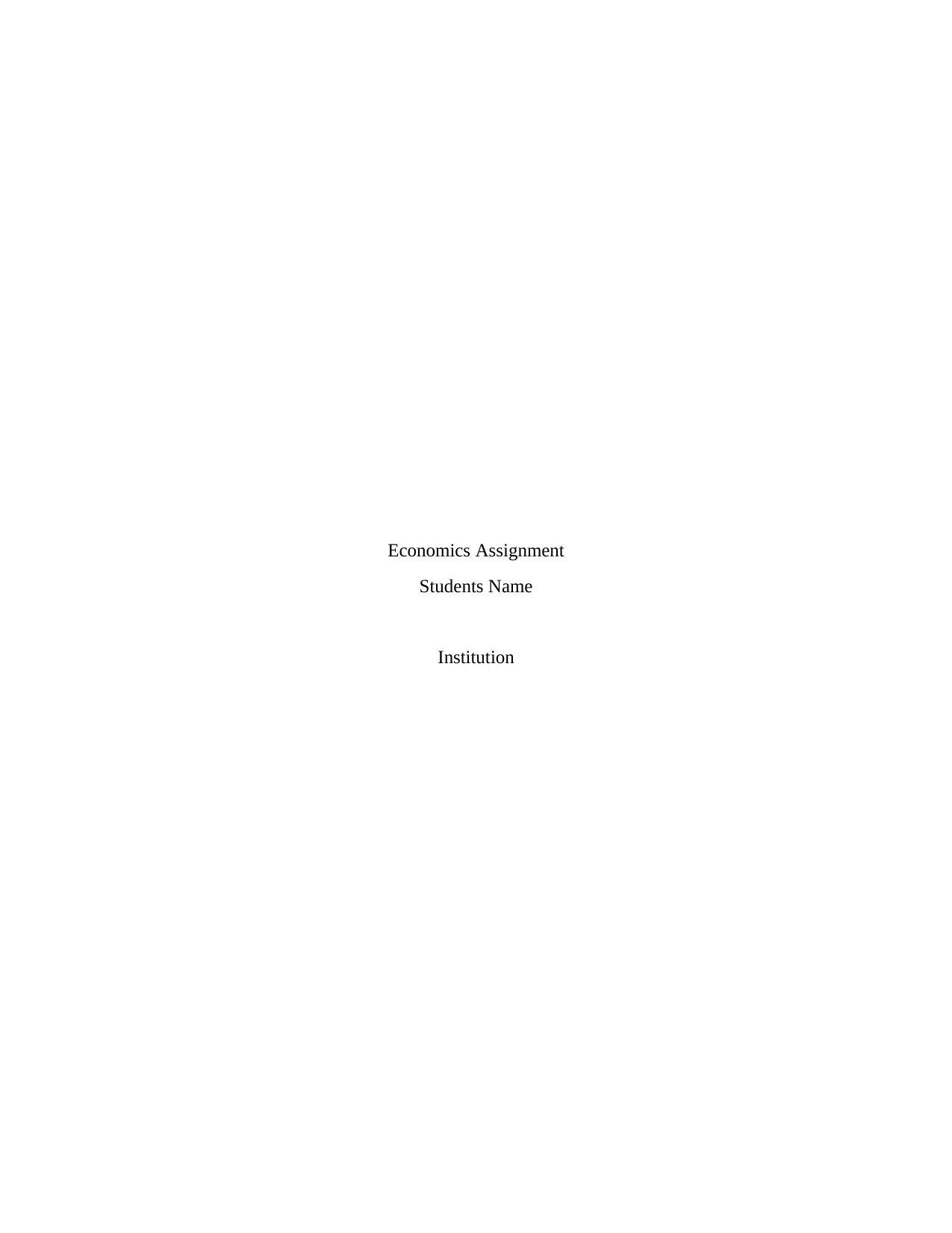
Economics Assignment
Students Name
Institution
Students Name
Institution
Paraphrase This Document
Need a fresh take? Get an instant paraphrase of this document with our AI Paraphraser
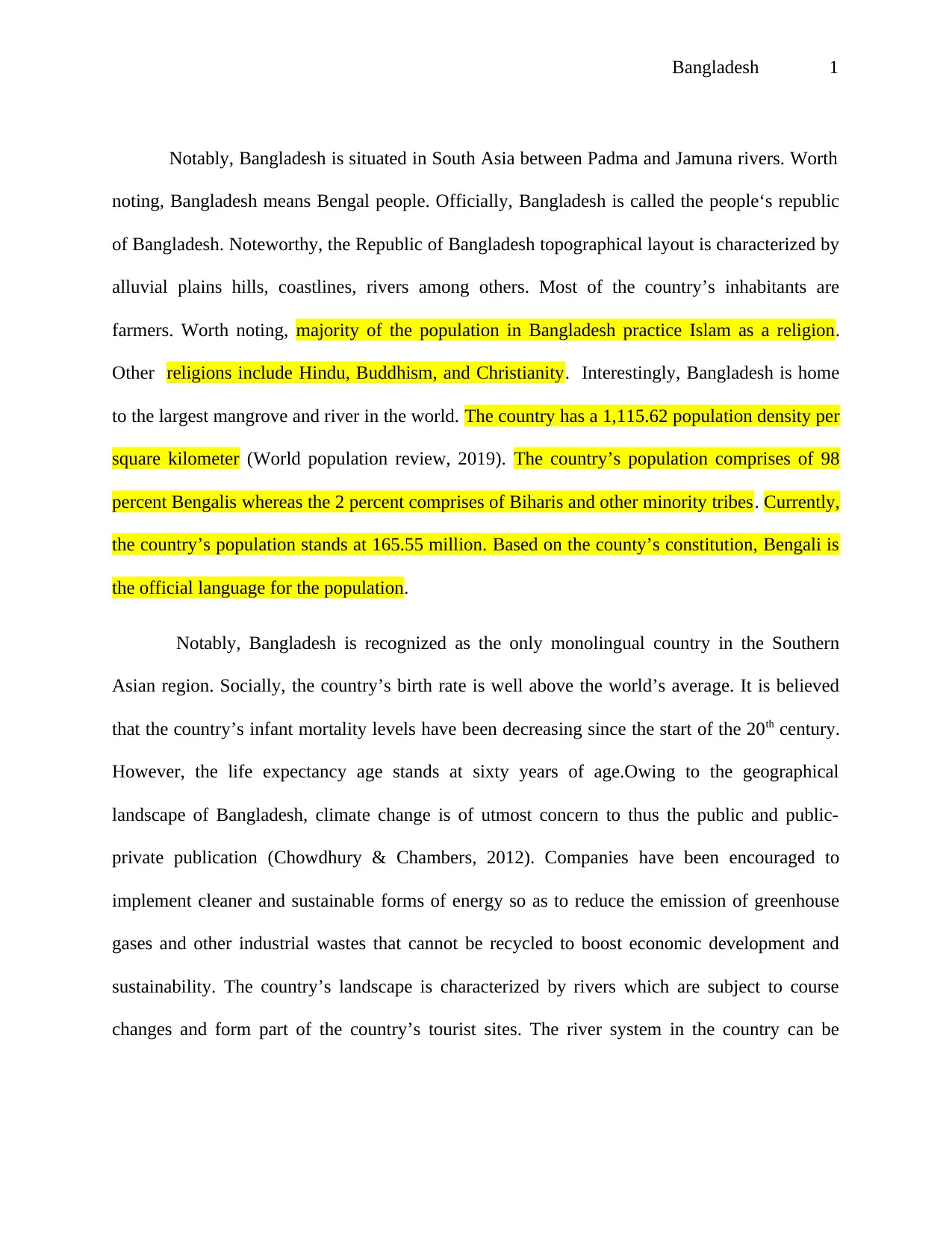
Bangladesh 1
Notably, Bangladesh is situated in South Asia between Padma and Jamuna rivers. Worth
noting, Bangladesh means Bengal people. Officially, Bangladesh is called the people‘s republic
of Bangladesh. Noteworthy, the Republic of Bangladesh topographical layout is characterized by
alluvial plains hills, coastlines, rivers among others. Most of the country’s inhabitants are
farmers. Worth noting, majority of the population in Bangladesh practice Islam as a religion.
Other religions include Hindu, Buddhism, and Christianity. Interestingly, Bangladesh is home
to the largest mangrove and river in the world. The country has a 1,115.62 population density per
square kilometer (World population review, 2019). The country’s population comprises of 98
percent Bengalis whereas the 2 percent comprises of Biharis and other minority tribes. Currently,
the country’s population stands at 165.55 million. Based on the county’s constitution, Bengali is
the official language for the population.
Notably, Bangladesh is recognized as the only monolingual country in the Southern
Asian region. Socially, the country’s birth rate is well above the world’s average. It is believed
that the country’s infant mortality levels have been decreasing since the start of the 20th century.
However, the life expectancy age stands at sixty years of age.Owing to the geographical
landscape of Bangladesh, climate change is of utmost concern to thus the public and public-
private publication (Chowdhury & Chambers, 2012). Companies have been encouraged to
implement cleaner and sustainable forms of energy so as to reduce the emission of greenhouse
gases and other industrial wastes that cannot be recycled to boost economic development and
sustainability. The country’s landscape is characterized by rivers which are subject to course
changes and form part of the country’s tourist sites. The river system in the country can be
Notably, Bangladesh is situated in South Asia between Padma and Jamuna rivers. Worth
noting, Bangladesh means Bengal people. Officially, Bangladesh is called the people‘s republic
of Bangladesh. Noteworthy, the Republic of Bangladesh topographical layout is characterized by
alluvial plains hills, coastlines, rivers among others. Most of the country’s inhabitants are
farmers. Worth noting, majority of the population in Bangladesh practice Islam as a religion.
Other religions include Hindu, Buddhism, and Christianity. Interestingly, Bangladesh is home
to the largest mangrove and river in the world. The country has a 1,115.62 population density per
square kilometer (World population review, 2019). The country’s population comprises of 98
percent Bengalis whereas the 2 percent comprises of Biharis and other minority tribes. Currently,
the country’s population stands at 165.55 million. Based on the county’s constitution, Bengali is
the official language for the population.
Notably, Bangladesh is recognized as the only monolingual country in the Southern
Asian region. Socially, the country’s birth rate is well above the world’s average. It is believed
that the country’s infant mortality levels have been decreasing since the start of the 20th century.
However, the life expectancy age stands at sixty years of age.Owing to the geographical
landscape of Bangladesh, climate change is of utmost concern to thus the public and public-
private publication (Chowdhury & Chambers, 2012). Companies have been encouraged to
implement cleaner and sustainable forms of energy so as to reduce the emission of greenhouse
gases and other industrial wastes that cannot be recycled to boost economic development and
sustainability. The country’s landscape is characterized by rivers which are subject to course
changes and form part of the country’s tourist sites. The river system in the country can be
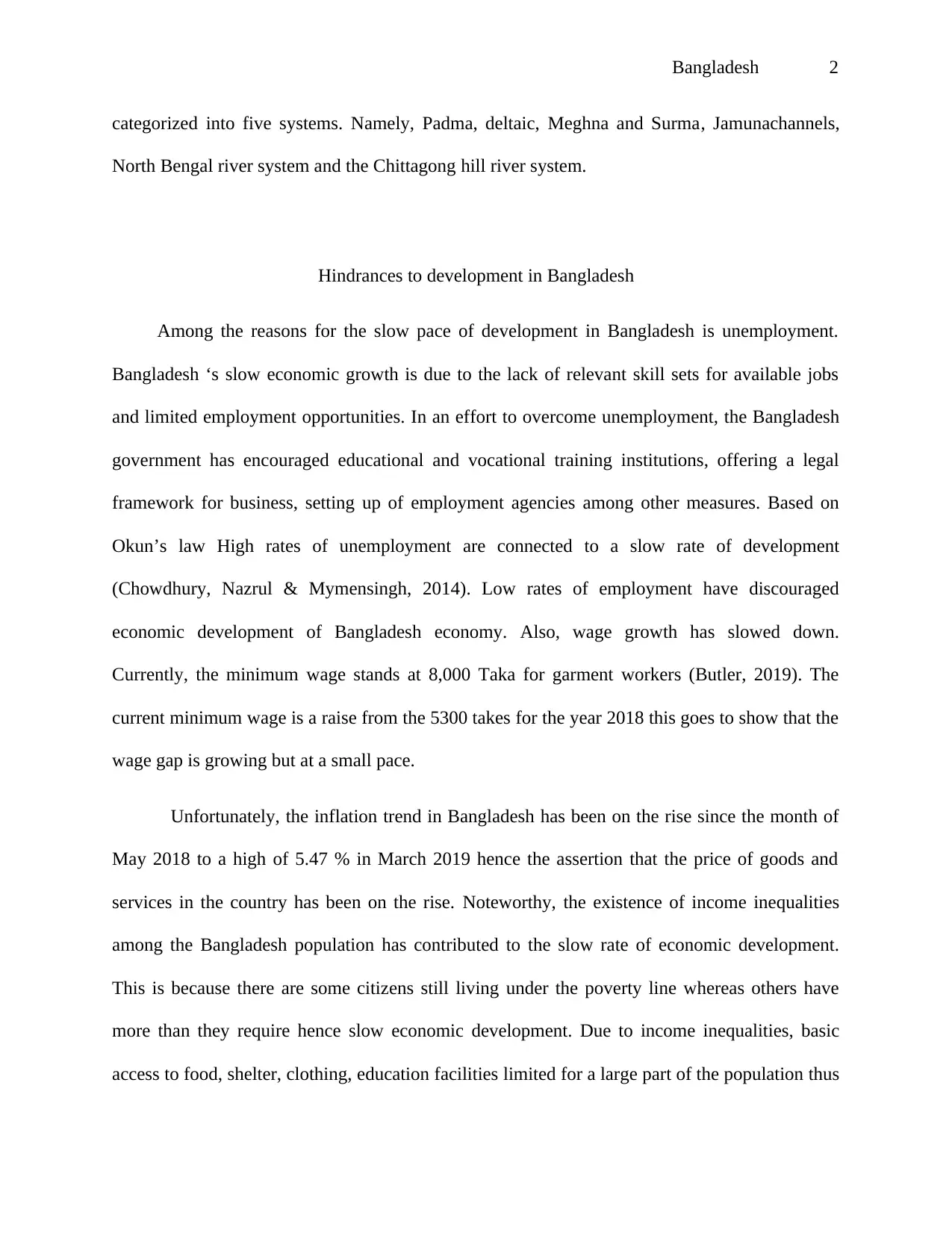
Bangladesh 2
categorized into five systems. Namely, Padma, deltaic, Meghna and Surma, Jamunachannels,
North Bengal river system and the Chittagong hill river system.
Hindrances to development in Bangladesh
Among the reasons for the slow pace of development in Bangladesh is unemployment.
Bangladesh ‘s slow economic growth is due to the lack of relevant skill sets for available jobs
and limited employment opportunities. In an effort to overcome unemployment, the Bangladesh
government has encouraged educational and vocational training institutions, offering a legal
framework for business, setting up of employment agencies among other measures. Based on
Okun’s law High rates of unemployment are connected to a slow rate of development
(Chowdhury, Nazrul & Mymensingh, 2014). Low rates of employment have discouraged
economic development of Bangladesh economy. Also, wage growth has slowed down.
Currently, the minimum wage stands at 8,000 Taka for garment workers (Butler, 2019). The
current minimum wage is a raise from the 5300 takes for the year 2018 this goes to show that the
wage gap is growing but at a small pace.
Unfortunately, the inflation trend in Bangladesh has been on the rise since the month of
May 2018 to a high of 5.47 % in March 2019 hence the assertion that the price of goods and
services in the country has been on the rise. Noteworthy, the existence of income inequalities
among the Bangladesh population has contributed to the slow rate of economic development.
This is because there are some citizens still living under the poverty line whereas others have
more than they require hence slow economic development. Due to income inequalities, basic
access to food, shelter, clothing, education facilities limited for a large part of the population thus
categorized into five systems. Namely, Padma, deltaic, Meghna and Surma, Jamunachannels,
North Bengal river system and the Chittagong hill river system.
Hindrances to development in Bangladesh
Among the reasons for the slow pace of development in Bangladesh is unemployment.
Bangladesh ‘s slow economic growth is due to the lack of relevant skill sets for available jobs
and limited employment opportunities. In an effort to overcome unemployment, the Bangladesh
government has encouraged educational and vocational training institutions, offering a legal
framework for business, setting up of employment agencies among other measures. Based on
Okun’s law High rates of unemployment are connected to a slow rate of development
(Chowdhury, Nazrul & Mymensingh, 2014). Low rates of employment have discouraged
economic development of Bangladesh economy. Also, wage growth has slowed down.
Currently, the minimum wage stands at 8,000 Taka for garment workers (Butler, 2019). The
current minimum wage is a raise from the 5300 takes for the year 2018 this goes to show that the
wage gap is growing but at a small pace.
Unfortunately, the inflation trend in Bangladesh has been on the rise since the month of
May 2018 to a high of 5.47 % in March 2019 hence the assertion that the price of goods and
services in the country has been on the rise. Noteworthy, the existence of income inequalities
among the Bangladesh population has contributed to the slow rate of economic development.
This is because there are some citizens still living under the poverty line whereas others have
more than they require hence slow economic development. Due to income inequalities, basic
access to food, shelter, clothing, education facilities limited for a large part of the population thus
⊘ This is a preview!⊘
Do you want full access?
Subscribe today to unlock all pages.

Trusted by 1+ million students worldwide
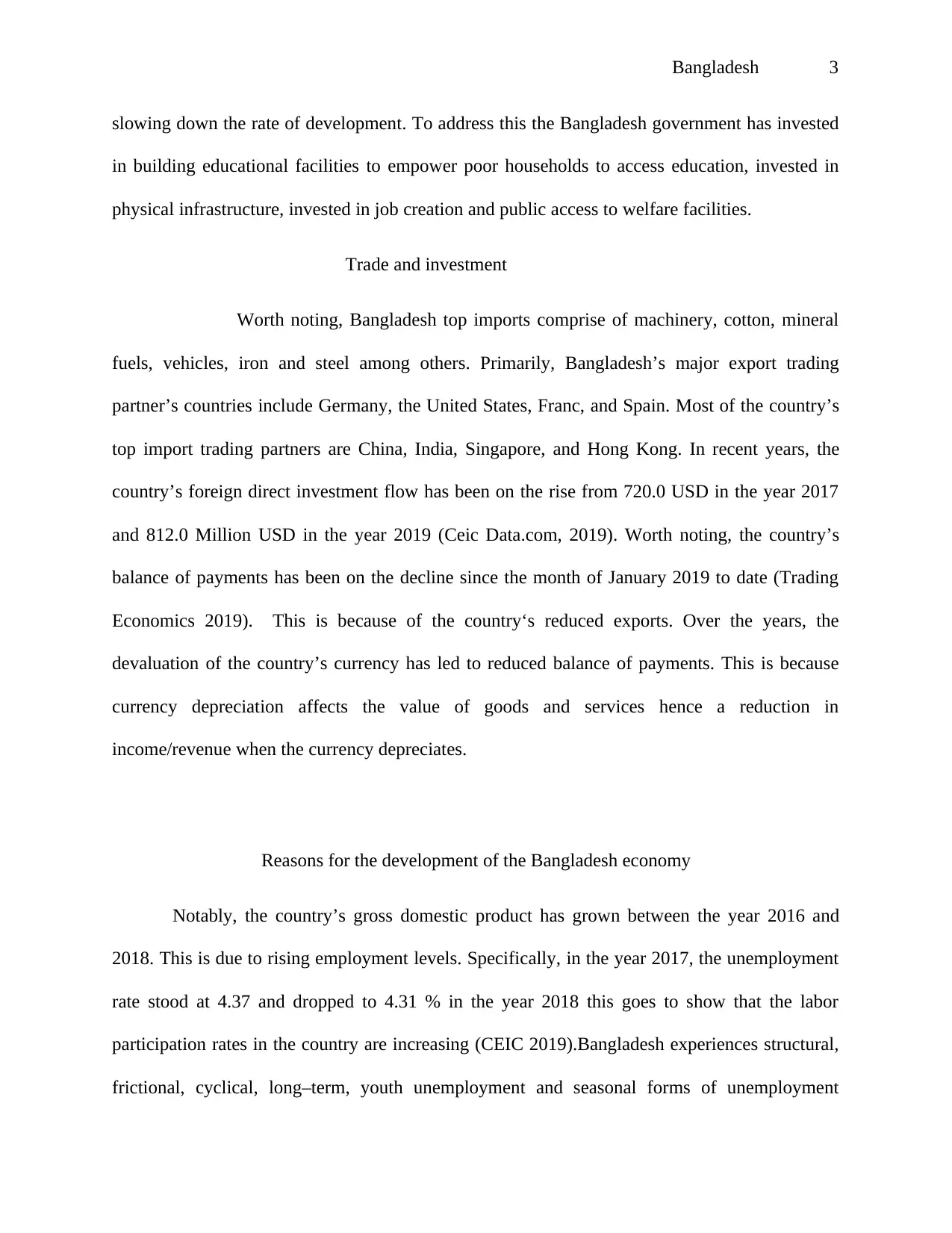
Bangladesh 3
slowing down the rate of development. To address this the Bangladesh government has invested
in building educational facilities to empower poor households to access education, invested in
physical infrastructure, invested in job creation and public access to welfare facilities.
Trade and investment
Worth noting, Bangladesh top imports comprise of machinery, cotton, mineral
fuels, vehicles, iron and steel among others. Primarily, Bangladesh’s major export trading
partner’s countries include Germany, the United States, Franc, and Spain. Most of the country’s
top import trading partners are China, India, Singapore, and Hong Kong. In recent years, the
country’s foreign direct investment flow has been on the rise from 720.0 USD in the year 2017
and 812.0 Million USD in the year 2019 (Ceic Data.com, 2019). Worth noting, the country’s
balance of payments has been on the decline since the month of January 2019 to date (Trading
Economics 2019). This is because of the country‘s reduced exports. Over the years, the
devaluation of the country’s currency has led to reduced balance of payments. This is because
currency depreciation affects the value of goods and services hence a reduction in
income/revenue when the currency depreciates.
Reasons for the development of the Bangladesh economy
Notably, the country’s gross domestic product has grown between the year 2016 and
2018. This is due to rising employment levels. Specifically, in the year 2017, the unemployment
rate stood at 4.37 and dropped to 4.31 % in the year 2018 this goes to show that the labor
participation rates in the country are increasing (CEIC 2019).Bangladesh experiences structural,
frictional, cyclical, long–term, youth unemployment and seasonal forms of unemployment
slowing down the rate of development. To address this the Bangladesh government has invested
in building educational facilities to empower poor households to access education, invested in
physical infrastructure, invested in job creation and public access to welfare facilities.
Trade and investment
Worth noting, Bangladesh top imports comprise of machinery, cotton, mineral
fuels, vehicles, iron and steel among others. Primarily, Bangladesh’s major export trading
partner’s countries include Germany, the United States, Franc, and Spain. Most of the country’s
top import trading partners are China, India, Singapore, and Hong Kong. In recent years, the
country’s foreign direct investment flow has been on the rise from 720.0 USD in the year 2017
and 812.0 Million USD in the year 2019 (Ceic Data.com, 2019). Worth noting, the country’s
balance of payments has been on the decline since the month of January 2019 to date (Trading
Economics 2019). This is because of the country‘s reduced exports. Over the years, the
devaluation of the country’s currency has led to reduced balance of payments. This is because
currency depreciation affects the value of goods and services hence a reduction in
income/revenue when the currency depreciates.
Reasons for the development of the Bangladesh economy
Notably, the country’s gross domestic product has grown between the year 2016 and
2018. This is due to rising employment levels. Specifically, in the year 2017, the unemployment
rate stood at 4.37 and dropped to 4.31 % in the year 2018 this goes to show that the labor
participation rates in the country are increasing (CEIC 2019).Bangladesh experiences structural,
frictional, cyclical, long–term, youth unemployment and seasonal forms of unemployment
Paraphrase This Document
Need a fresh take? Get an instant paraphrase of this document with our AI Paraphraser
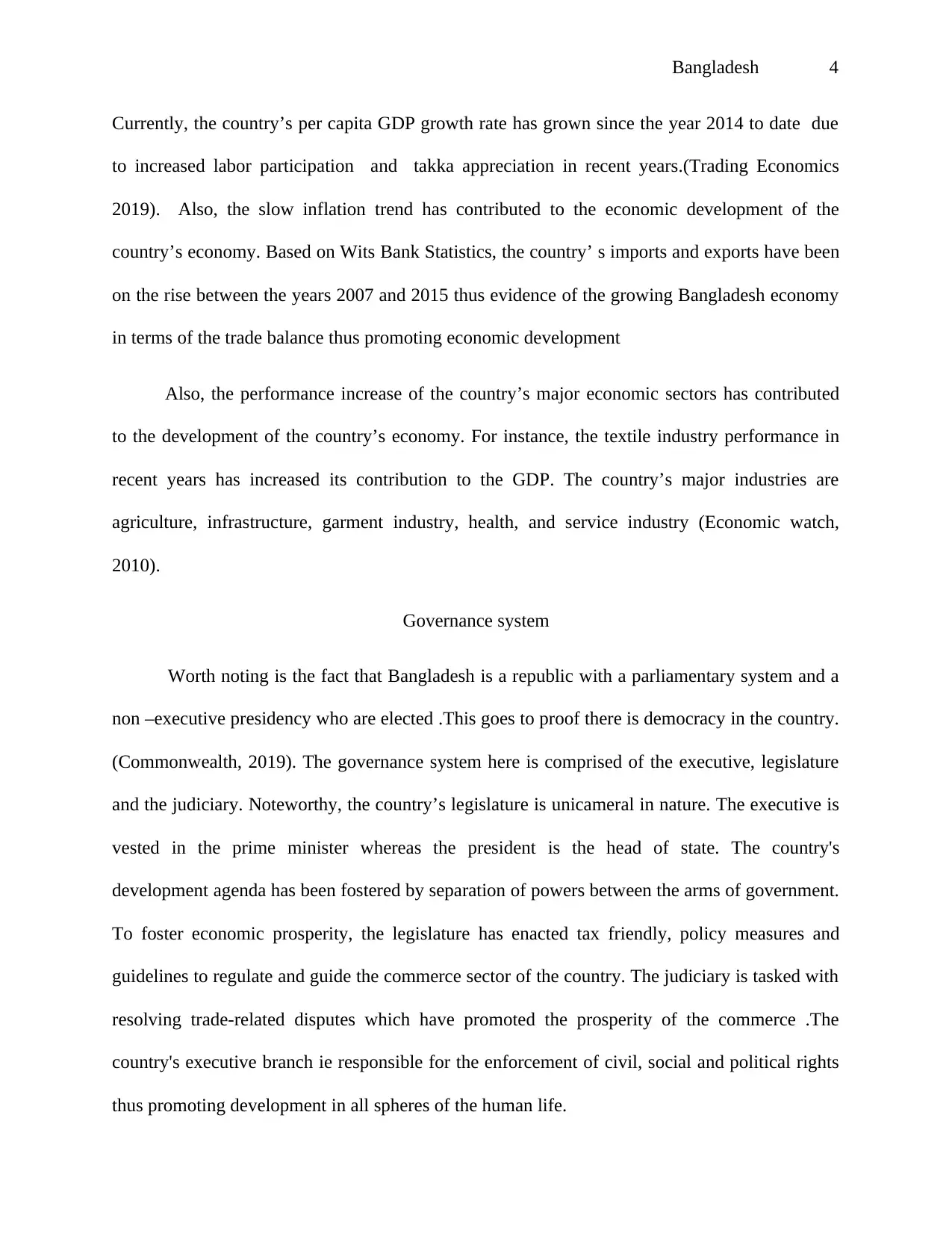
Bangladesh 4
Currently, the country’s per capita GDP growth rate has grown since the year 2014 to date due
to increased labor participation and takka appreciation in recent years.(Trading Economics
2019). Also, the slow inflation trend has contributed to the economic development of the
country’s economy. Based on Wits Bank Statistics, the country’ s imports and exports have been
on the rise between the years 2007 and 2015 thus evidence of the growing Bangladesh economy
in terms of the trade balance thus promoting economic development
Also, the performance increase of the country’s major economic sectors has contributed
to the development of the country’s economy. For instance, the textile industry performance in
recent years has increased its contribution to the GDP. The country’s major industries are
agriculture, infrastructure, garment industry, health, and service industry (Economic watch,
2010).
Governance system
Worth noting is the fact that Bangladesh is a republic with a parliamentary system and a
non –executive presidency who are elected .This goes to proof there is democracy in the country.
(Commonwealth, 2019). The governance system here is comprised of the executive, legislature
and the judiciary. Noteworthy, the country’s legislature is unicameral in nature. The executive is
vested in the prime minister whereas the president is the head of state. The country's
development agenda has been fostered by separation of powers between the arms of government.
To foster economic prosperity, the legislature has enacted tax friendly, policy measures and
guidelines to regulate and guide the commerce sector of the country. The judiciary is tasked with
resolving trade-related disputes which have promoted the prosperity of the commerce .The
country's executive branch ie responsible for the enforcement of civil, social and political rights
thus promoting development in all spheres of the human life.
Currently, the country’s per capita GDP growth rate has grown since the year 2014 to date due
to increased labor participation and takka appreciation in recent years.(Trading Economics
2019). Also, the slow inflation trend has contributed to the economic development of the
country’s economy. Based on Wits Bank Statistics, the country’ s imports and exports have been
on the rise between the years 2007 and 2015 thus evidence of the growing Bangladesh economy
in terms of the trade balance thus promoting economic development
Also, the performance increase of the country’s major economic sectors has contributed
to the development of the country’s economy. For instance, the textile industry performance in
recent years has increased its contribution to the GDP. The country’s major industries are
agriculture, infrastructure, garment industry, health, and service industry (Economic watch,
2010).
Governance system
Worth noting is the fact that Bangladesh is a republic with a parliamentary system and a
non –executive presidency who are elected .This goes to proof there is democracy in the country.
(Commonwealth, 2019). The governance system here is comprised of the executive, legislature
and the judiciary. Noteworthy, the country’s legislature is unicameral in nature. The executive is
vested in the prime minister whereas the president is the head of state. The country's
development agenda has been fostered by separation of powers between the arms of government.
To foster economic prosperity, the legislature has enacted tax friendly, policy measures and
guidelines to regulate and guide the commerce sector of the country. The judiciary is tasked with
resolving trade-related disputes which have promoted the prosperity of the commerce .The
country's executive branch ie responsible for the enforcement of civil, social and political rights
thus promoting development in all spheres of the human life.
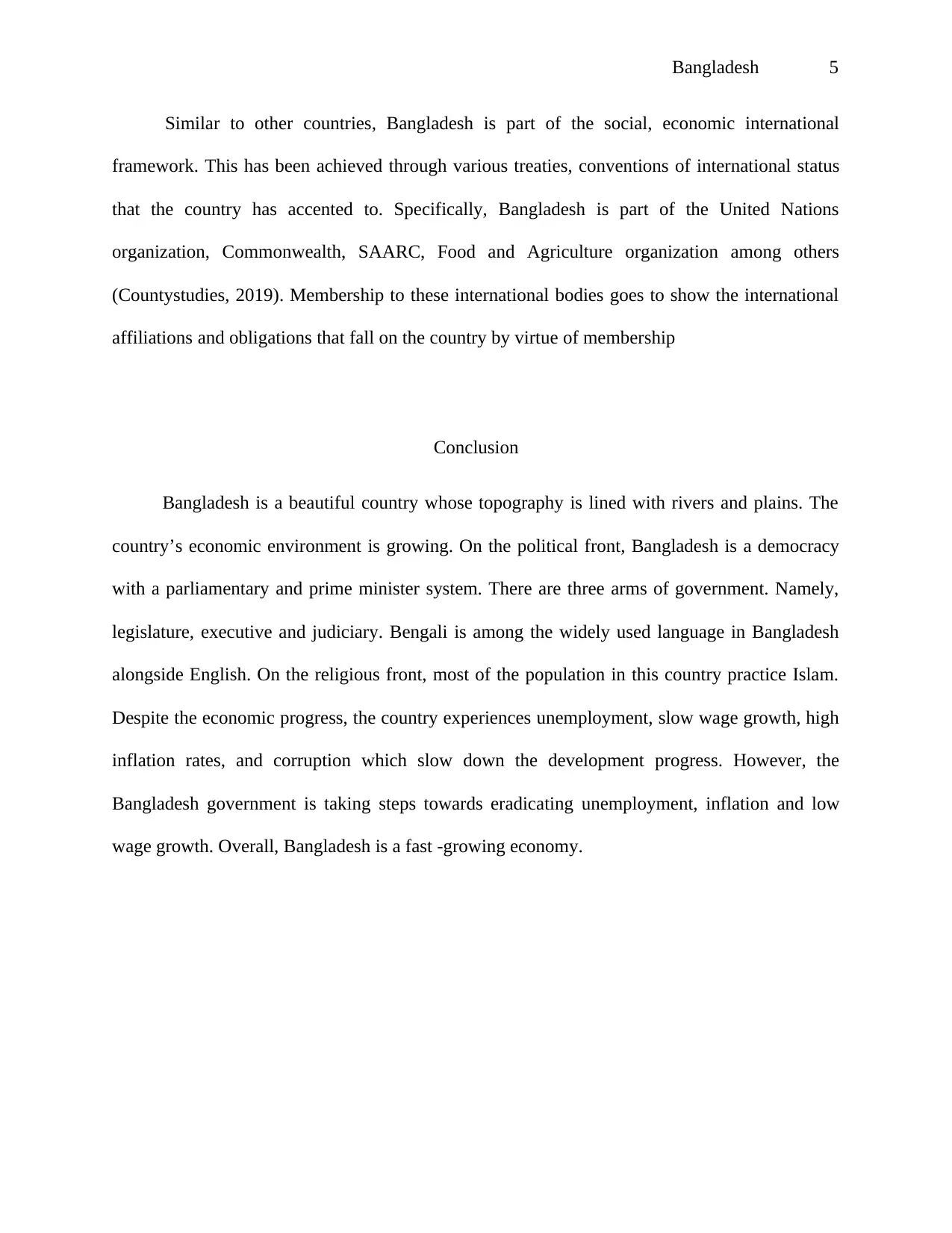
Bangladesh 5
Similar to other countries, Bangladesh is part of the social, economic international
framework. This has been achieved through various treaties, conventions of international status
that the country has accented to. Specifically, Bangladesh is part of the United Nations
organization, Commonwealth, SAARC, Food and Agriculture organization among others
(Countystudies, 2019). Membership to these international bodies goes to show the international
affiliations and obligations that fall on the country by virtue of membership
Conclusion
Bangladesh is a beautiful country whose topography is lined with rivers and plains. The
country’s economic environment is growing. On the political front, Bangladesh is a democracy
with a parliamentary and prime minister system. There are three arms of government. Namely,
legislature, executive and judiciary. Bengali is among the widely used language in Bangladesh
alongside English. On the religious front, most of the population in this country practice Islam.
Despite the economic progress, the country experiences unemployment, slow wage growth, high
inflation rates, and corruption which slow down the development progress. However, the
Bangladesh government is taking steps towards eradicating unemployment, inflation and low
wage growth. Overall, Bangladesh is a fast -growing economy.
Similar to other countries, Bangladesh is part of the social, economic international
framework. This has been achieved through various treaties, conventions of international status
that the country has accented to. Specifically, Bangladesh is part of the United Nations
organization, Commonwealth, SAARC, Food and Agriculture organization among others
(Countystudies, 2019). Membership to these international bodies goes to show the international
affiliations and obligations that fall on the country by virtue of membership
Conclusion
Bangladesh is a beautiful country whose topography is lined with rivers and plains. The
country’s economic environment is growing. On the political front, Bangladesh is a democracy
with a parliamentary and prime minister system. There are three arms of government. Namely,
legislature, executive and judiciary. Bengali is among the widely used language in Bangladesh
alongside English. On the religious front, most of the population in this country practice Islam.
Despite the economic progress, the country experiences unemployment, slow wage growth, high
inflation rates, and corruption which slow down the development progress. However, the
Bangladesh government is taking steps towards eradicating unemployment, inflation and low
wage growth. Overall, Bangladesh is a fast -growing economy.
⊘ This is a preview!⊘
Do you want full access?
Subscribe today to unlock all pages.

Trusted by 1+ million students worldwide
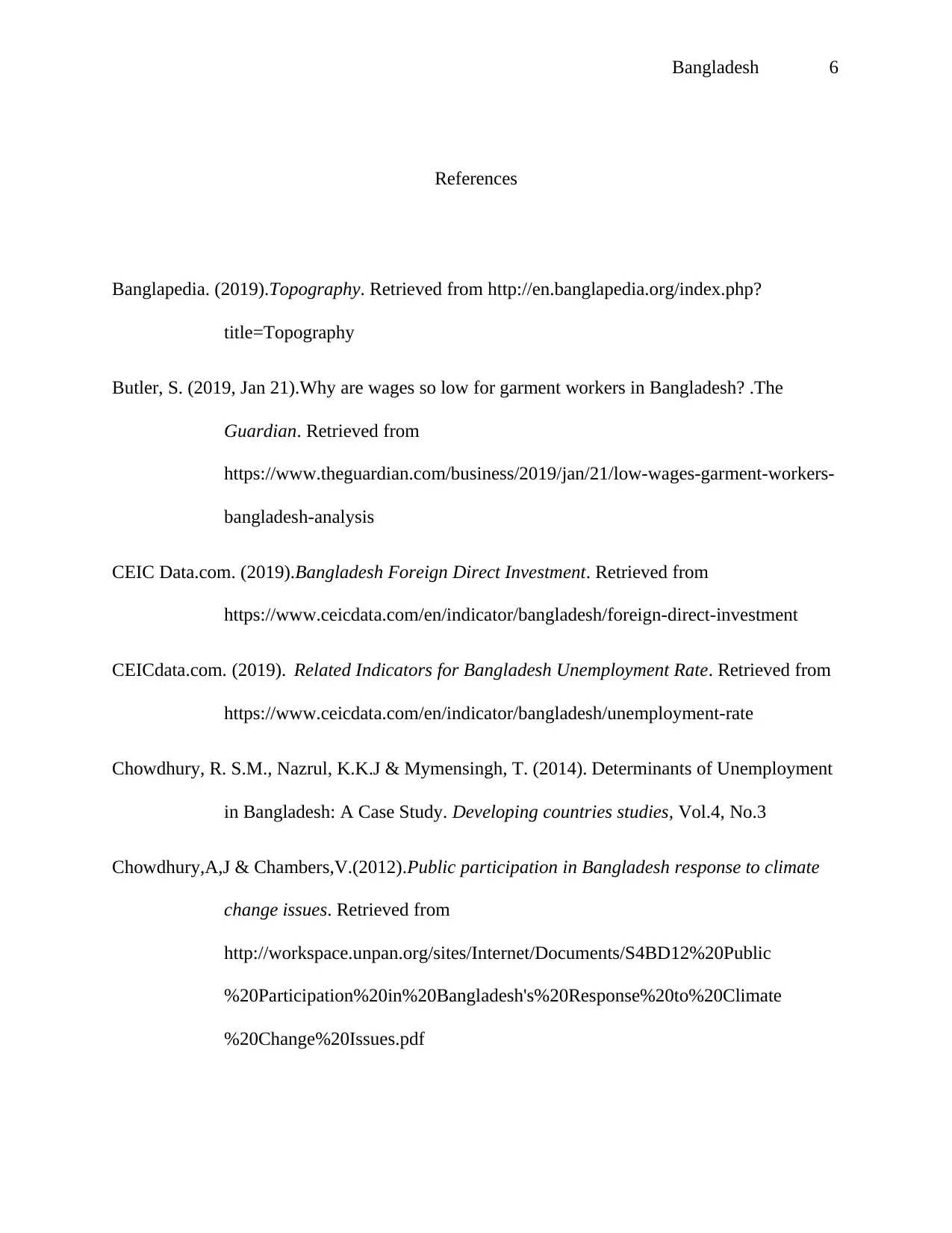
Bangladesh 6
References
Banglapedia. (2019).Topography. Retrieved from http://en.banglapedia.org/index.php?
title=Topography
Butler, S. (2019, Jan 21).Why are wages so low for garment workers in Bangladesh? .The
Guardian. Retrieved from
https://www.theguardian.com/business/2019/jan/21/low-wages-garment-workers-
bangladesh-analysis
CEIC Data.com. (2019).Bangladesh Foreign Direct Investment. Retrieved from
https://www.ceicdata.com/en/indicator/bangladesh/foreign-direct-investment
CEICdata.com. (2019). Related Indicators for Bangladesh Unemployment Rate. Retrieved from
https://www.ceicdata.com/en/indicator/bangladesh/unemployment-rate
Chowdhury, R. S.M., Nazrul, K.K.J & Mymensingh, T. (2014). Determinants of Unemployment
in Bangladesh: A Case Study. Developing countries studies, Vol.4, No.3
Chowdhury,A,J & Chambers,V.(2012).Public participation in Bangladesh response to climate
change issues. Retrieved from
http://workspace.unpan.org/sites/Internet/Documents/S4BD12%20Public
%20Participation%20in%20Bangladesh's%20Response%20to%20Climate
%20Change%20Issues.pdf
References
Banglapedia. (2019).Topography. Retrieved from http://en.banglapedia.org/index.php?
title=Topography
Butler, S. (2019, Jan 21).Why are wages so low for garment workers in Bangladesh? .The
Guardian. Retrieved from
https://www.theguardian.com/business/2019/jan/21/low-wages-garment-workers-
bangladesh-analysis
CEIC Data.com. (2019).Bangladesh Foreign Direct Investment. Retrieved from
https://www.ceicdata.com/en/indicator/bangladesh/foreign-direct-investment
CEICdata.com. (2019). Related Indicators for Bangladesh Unemployment Rate. Retrieved from
https://www.ceicdata.com/en/indicator/bangladesh/unemployment-rate
Chowdhury, R. S.M., Nazrul, K.K.J & Mymensingh, T. (2014). Determinants of Unemployment
in Bangladesh: A Case Study. Developing countries studies, Vol.4, No.3
Chowdhury,A,J & Chambers,V.(2012).Public participation in Bangladesh response to climate
change issues. Retrieved from
http://workspace.unpan.org/sites/Internet/Documents/S4BD12%20Public
%20Participation%20in%20Bangladesh's%20Response%20to%20Climate
%20Change%20Issues.pdf
Paraphrase This Document
Need a fresh take? Get an instant paraphrase of this document with our AI Paraphraser
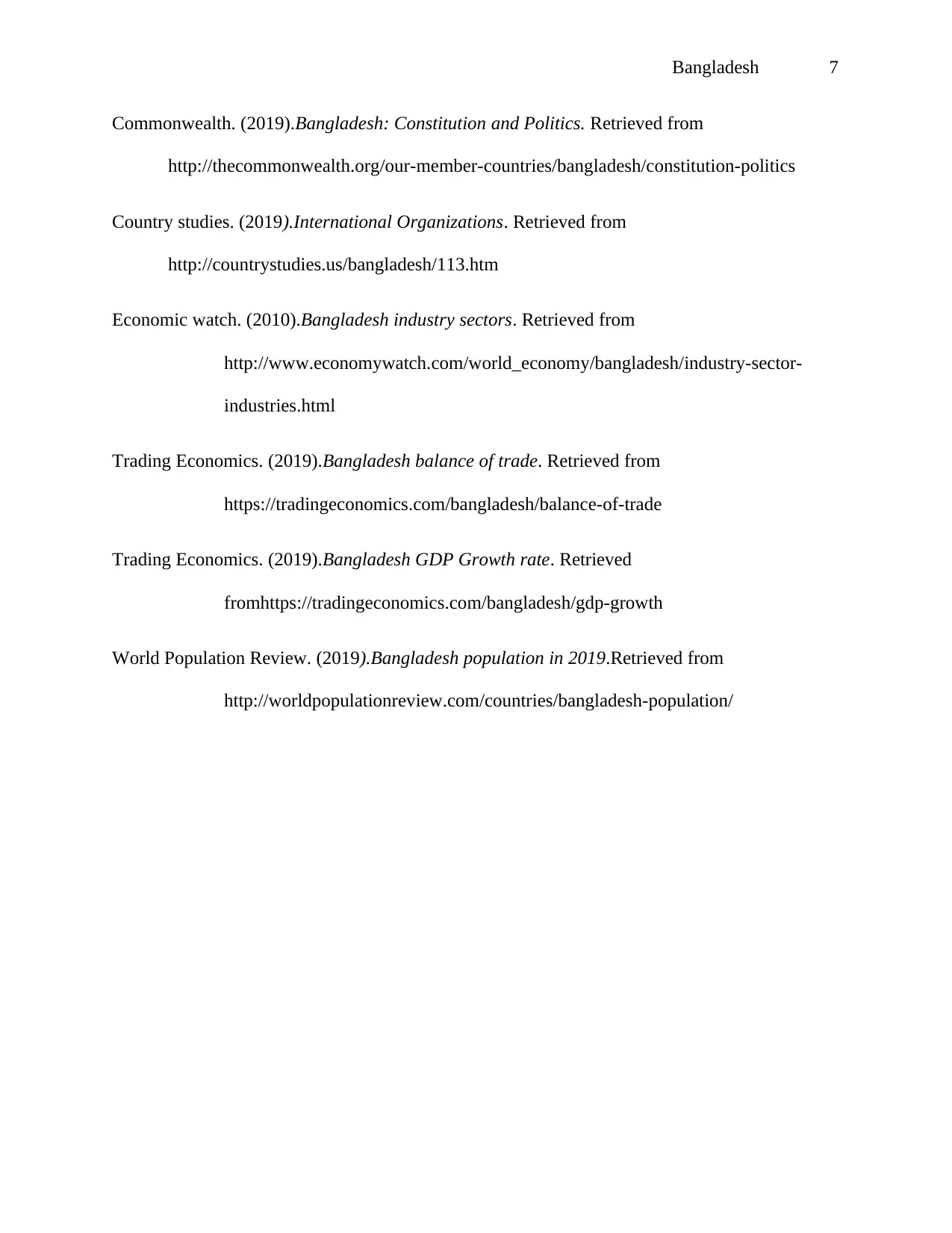
Bangladesh 7
Commonwealth. (2019).Bangladesh: Constitution and Politics. Retrieved from
http://thecommonwealth.org/our-member-countries/bangladesh/constitution-politics
Country studies. (2019).International Organizations. Retrieved from
http://countrystudies.us/bangladesh/113.htm
Economic watch. (2010).Bangladesh industry sectors. Retrieved from
http://www.economywatch.com/world_economy/bangladesh/industry-sector-
industries.html
Trading Economics. (2019).Bangladesh balance of trade. Retrieved from
https://tradingeconomics.com/bangladesh/balance-of-trade
Trading Economics. (2019).Bangladesh GDP Growth rate. Retrieved
fromhttps://tradingeconomics.com/bangladesh/gdp-growth
World Population Review. (2019).Bangladesh population in 2019.Retrieved from
http://worldpopulationreview.com/countries/bangladesh-population/
Commonwealth. (2019).Bangladesh: Constitution and Politics. Retrieved from
http://thecommonwealth.org/our-member-countries/bangladesh/constitution-politics
Country studies. (2019).International Organizations. Retrieved from
http://countrystudies.us/bangladesh/113.htm
Economic watch. (2010).Bangladesh industry sectors. Retrieved from
http://www.economywatch.com/world_economy/bangladesh/industry-sector-
industries.html
Trading Economics. (2019).Bangladesh balance of trade. Retrieved from
https://tradingeconomics.com/bangladesh/balance-of-trade
Trading Economics. (2019).Bangladesh GDP Growth rate. Retrieved
fromhttps://tradingeconomics.com/bangladesh/gdp-growth
World Population Review. (2019).Bangladesh population in 2019.Retrieved from
http://worldpopulationreview.com/countries/bangladesh-population/
1 out of 8
Your All-in-One AI-Powered Toolkit for Academic Success.
+13062052269
info@desklib.com
Available 24*7 on WhatsApp / Email
![[object Object]](/_next/static/media/star-bottom.7253800d.svg)
Unlock your academic potential
Copyright © 2020–2025 A2Z Services. All Rights Reserved. Developed and managed by ZUCOL.

